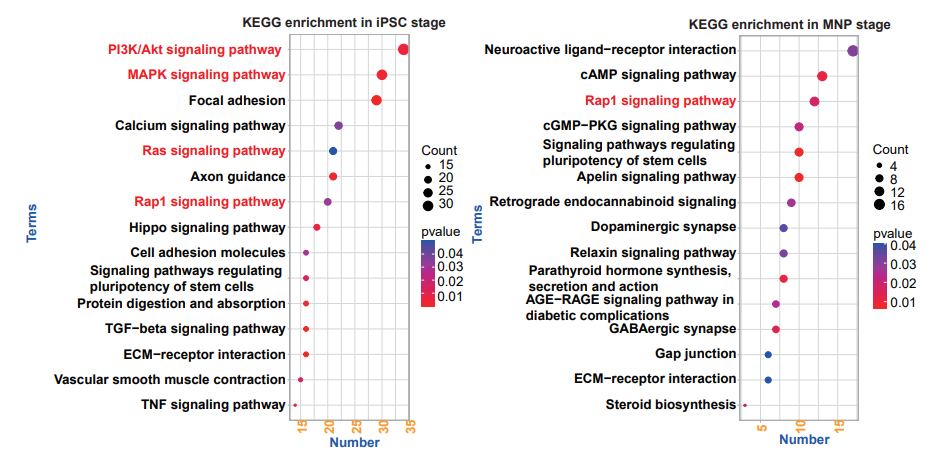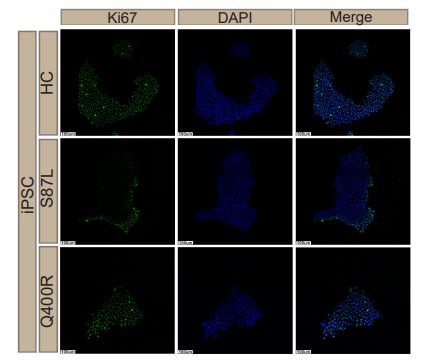中国神经再生研究(英文版) ›› 2024, Vol. 19 ›› Issue (1): 205-211.doi: 10.4103/1673-5374.375347
MORC2 p.S87L突变抑制相关信号通路导致脊髓肌萎缩样表型诱导多能干细胞增殖障碍
The MORC2 p.S87L mutation reduces proliferation of pluripotent stem cells derived from a patient with the spinal muscular atrophy-like phenotype by inhibiting proliferation-related signaling pathways
Sen Zeng1, #, Honglan Yang1, #, Binghao Wang2, Yongzhi Xie3, Ke Xu1, Lei Liu1, 4, Wanqian Cao1, Xionghao Liu5, Beisha Tang6, Mujun Liu7, *, Ruxu Zhang1, *#br#
- 1Department of Neurology, The Third Xiangya Hospital, Central South University, Changsha, Hunan Province, China; 2Department of Neurology, The First Affiliated Hospital of Zhengzhou University, Zhengzhou, Henan Province, China; 3Department of Radiology, The Third Xiangya Hospital, Central South University, Changsha, Hunan Province, China; 4Health Management Center, The Third Xiangya Hospital, Central South University, Changsha, Hunan Province, China; 5Center for Medical Genetics & Hunan Key Laboratory of Medical Genetics, School of Life Sciences, Central South University, Changsha, Hunan Province, China; 6National Clinical Research Center for Geriatric Disorders, Central South University, Changsha, Hunan Province, China; 7Department of Cell Biology, School of Life Sciences, Central South University, Changsha, Hunan Province, China
摘要:
染色质重塑蛋白MORC家族CW型锌指结构蛋白2 (MORC2)是腓骨肌萎缩2Z型的致病基因,其热点突变p.S87L与更严重的脊髓性肌萎缩症样临床表型有关。为了解MORC2 p.S87L突变导致严重临床表型的潜在机制,实验收集了脊髓性肌萎缩样患者(MORC2 p.S87L)、腓骨肌萎缩2Z型患者(MOLC2 p.Q400R)以及健康对照的尿液上皮细胞,诱导产生多能干细胞,再分化为运动神经元前体。经RNA测序和KEGG富集分析发现,PI3K/Akt和MAPK/ERK信号通路在脊髓性肌萎缩样患者来源细胞中富集,且在多能干细胞阶段显著下调。与腓骨肌萎缩2Z型和健康对照来源细胞相比,脊髓性肌萎缩样患者来源细胞在多能干细胞和运动神经元前体阶段的增殖明显减少,且在多能干细胞阶段存在G0/G1期阻滞。在多能干细胞阶段中以特异性反义寡核苷酸沉默MORC2 p.S87L,可见的改善细胞增殖和PI3K/Akt和MAPK/ERK通路活化明显恢复,但在运动神经元前体阶段干预则对细胞增殖无显著效果。上述发现表明,多能干细胞阶段细胞增殖减少和G0/G1期阻滞可能是通过下调PI3K/Akt和MAPK/ERK信号通路导致了严重的脊髓性肌萎缩症样表型,且早期靶向MORC2 p.S87L突变的反义寡核苷酸基因沉默治疗能够改善诱导性多能干细胞阶段的增殖障碍。
https://orcid.org/0000-0003-3823-8148 (Ruxu Zhang); https://orcid.org/0000-0002-1558-1448 (Mujun Liu)


